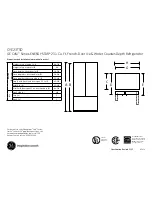
Page 9 of 16
NOTE:
Depending on the ambient temperature, it can take 2–5 hours until the appliance
has reached the desired operating temperature.
During this phase, the appliance may make operating noises. These will decrease once the
set temperature has been reached.
Controlling the Temperature
Many factors may influence the internal temperature of the Retro Fridge and freezer
compartments.
•
The combination of food and containers stored
•
The temperature and humidity of the surrounding environment.
•
The opening frequency of the doors, and the amount of warm food placed in the
Retro Fridge.
•
For these reasons, you may want to adjust the control to suit the season and your
needs.
•
The cord should neither be lengthened nor folded into a coil during operation. It
is not recommended that the cord is kept close to the compressor at the back of
the Retro Fridge as the surface temperature is quite high when operating. Making
contact with the two would de-activate the insulation or cause leakage of
electricity.
•
Put food in the Retro Fridge after running the Retro Fridge for 2-3 hours.
5. Temperature Control
You can use the temperature control
to adjust the cooling performance of your appliance to
suit your requirements.
In addition, it may be necessary to adjust the cooling level depending on the environmental
temperature.
You can choose a cooling level from 0–7. The higher the cooling level, the higher the cooling
performance.
•
Cooling level
0: no cooling
•
Cooling level
1–2: low cooling performance, use if the ambient temperature is cold.
•
Cooling level
3–5: medium cooling performance, use in standard household ambient
temperatures.
•
Cooling level
6–7: high cooling performance, use in warm ambient temperatures.
Note:
For daily use in the household, we recommend a medium cooling level.
If you choose cooling level "0", the appliance does not chill but is still switched on.
To switch off the appliance completely, pull the plug from the mains power point.


































